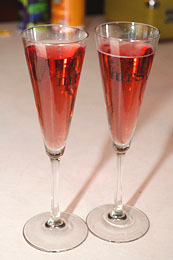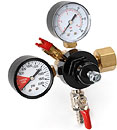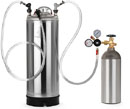 …I decided to try a sparkling wine and to make it sweet. The 5 gallon batch of strawberry from a concentrate was made to about 8-9% PA, and allowed to finish, then I added a syrup of 2-1/4 ounces/gallon and bottled it in the proper bottles. The sparkling part turned out very well, but the taste is anything but sweet. My question is how to make it sparkling and yet to preserve the sweetness? I’m not really equipped to do it the proper way with reopening the bottles and preserving and sweetening at that time. I followed an “easy way” recipe. Is this possible?
…I decided to try a sparkling wine and to make it sweet. The 5 gallon batch of strawberry from a concentrate was made to about 8-9% PA, and allowed to finish, then I added a syrup of 2-1/4 ounces/gallon and bottled it in the proper bottles. The sparkling part turned out very well, but the taste is anything but sweet. My question is how to make it sparkling and yet to preserve the sweetness? I’m not really equipped to do it the proper way with reopening the bottles and preserving and sweetening at that time. I followed an “easy way” recipe. Is this possible?
Name: Lee C.
State: OH
—–
Hello Lee,
Making a sweet, sparking wine is something that the home winemaker can not do in a practical manner, and in fact, can be dangerous, if attempted and done incorrectly!
The real issue is that the amount of sparkle or CO2 gas in the wine is controlled by how much sugar it has at bottling time. Once bottled, sugars are fermented into more alcohol and CO2 gas. The CO2 gas provides the carbonation — the sparkle. This is why your sparkling wine ended up dry. The sweetness was spent on the sparkle.
If you try to compensate for the sparkle by adding even more sugar, then you’ve entered the danger zone. The yeast can create much more pressure than any Champagne bottle can hold, if given the opportunity. The result can easily be exploding Champagne bottles — something you do not want to be anywhere near when they go off. This is not how to make sweet sparking wine.
This brings up the question then: “Well then, how do the commercial wineries make sweet sparkling wines?” The answer is simple. They start by making a sweet wine. Then they stabilize it through both preservatives and very fine filtration to remove the wine yeast. Then they force-carbonate the wine with CO2 gas under pressure.
Force-carbonating the wine with CO2 gas is done by chilling the wine down to just above freezing. This causes the wine to be able to absorb CO2 gas more readily. Then the CO2 gas is charged or forced into the sweet wine.
The process of how to make a sweet sparkling wine is really no different than how commercial soda or beer is carbonated. They do it the same way, only with these beverages the resulting pressure they are under is about 35 PSI (pounds per square inch) of CO2, whereas a sparkling wine is around 65 to 75 PSI.
 Force-carbonating a sweet wine with CO2 gas is something that can be done by the home winemaker but not without making a sizable investment. First you will need a tank to put the wine in for charging the CO2. A soda canister or corny keg works good for this purpose. Then you will need a CO2 tank and a CO2 regulator. The tank provides the CO2. The regulator allows you to control how much pressure comes out of the tank.
Force-carbonating a sweet wine with CO2 gas is something that can be done by the home winemaker but not without making a sizable investment. First you will need a tank to put the wine in for charging the CO2. A soda canister or corny keg works good for this purpose. Then you will need a CO2 tank and a CO2 regulator. The tank provides the CO2. The regulator allows you to control how much pressure comes out of the tank.
You will need to force-carbonate the sweet wine at 45 PSI on the regulator. Keep the wine under this pressure for a few days, but 2 or 3 weeks would be even better. This will allow time for the CO2 gas to come completely into solution with the wine, making it harder for the gas to escape upon depressurization. The wine will need to be around 30°F. during this time.
Once force-carbonated the sweet wine will need to be filled into Champagne bottles with a counter pressure bottling filling system. This is an apparatus the will fill the Champagne while keeping the bottle under pressure.
 It is important to note here that if you are investing in such equipment you may want to forget all about the bottling part and simply serve your sparkling wine on tap. Here is a kegging kit that would allow you to do that. You could also hook it up to a bar with the commercial faucet tap system.
It is important to note here that if you are investing in such equipment you may want to forget all about the bottling part and simply serve your sparkling wine on tap. Here is a kegging kit that would allow you to do that. You could also hook it up to a bar with the commercial faucet tap system.
So that’s how to make a sweet sparkling wine. While it is a little bit of an investment it is a lot of fun and does a good job.
Best Wishes,
Ed Kraus
———————————————————————————————————
Ed Kraus is a 3rd generation home brewer/winemaker and has been an owner of E. C. Kraus since 1999. He has been helping individuals make better wine and beer for over 25 years.

There is one more way to do it. Add the sweetner when you open it.
I really enjoy your articles. I have some information about making sweet sparkling wine. I have been doing this quite successfully and safely for 19 years using the following recipe and the methode champenoise. Starting with the following range of S. G.(dry 1.080 to 1.090, semi dry 1.095 to 1.115, semi sweet 1.120 to 1.125, and sweet 1.125 to 1.140 and up) I allow the S. G. to drop 80 points. I then bottle the wine in sparkling wine bottles, seal with a crown cap and begin the remuage process. I have made hundreds of bottles in every style I could find with this method and have had no
problems. My personal favorite is semi sweet rhubarb but most of my friends prefer semi sweet vitis raparia cold duck. A very good reference is "How to Make Wines With a Sparkle" by John Restall and Donald Hebbs, ISBN: 0-9619072-6-6.
Thanks again for all of your advice and assistance to the home wine maker.
Hi Kenneth, im atempting to make a fejoa sparkling wine. Ive made a few batches but it’s soo dry it’s hard to enjoy without mixing it. Could you please elaborate on your method to produce a sweeter one? I talked to the guy at my local brew shop and he suggested adding a sweetener such as lactose that apparently yest won’t convert at the bottling stage along with the sucrose needed for the sparkle. Has anyone had any success using this method? Many thanks mo
Jay, when you add the sweetener to your sparkling wine, you will start the CO2 and wine coming out of the bottle. You can reduce the amount of discharge by chilling the wine and adding the sweetener that has been chilled also to a lower temperature than the wine in the bottle.
A couple of thoughts on all that. What about adding sugar and stevia at bottling? The sugar would add the sparkle, and the yeast would leave the stevia alone allowing the wine to remain sweet. . . . Another thought might be using a soda-stream, on a glass by glass basis, and instead of putting water in the machine, put your sweet wine. . . Any thoughts about that?
Is it really the case that home winemakers *cannot* make sweet sparkling wines at home? Historically, champagne was usually sweeter than the varieties found on supermarket shelves today, and this was produced without forced carbonation.
The champagne method includes:
1. Making a still white wine
2. Bottling with a precise amount of sugar (to be fully consumed by yeast for carbonation). Result: a bone dry sparkling wine
3. Bottle aged for at least 15 months
4. Yeast forced into the bottle top by manually agitating the bottle over a number of weeks, gradually inverting it
5. Disgorgement: putting the inverted bottle into icy brine (typically about -15C) to freeze the yeast and a bit of the wine. Then open the cap to blow this frozen plug from the bottle
6. Add “dosage” – a sweetened base wine
My question in all this is how you prevent the dosage from possibly starting another fermentation. Can we be certain that the ejection of the icy plug has removed all yeast? Has the 15 months of aging killed off any residual yeast? I’m far from certain I’m both cases, but know that this has been done for centuries.
Unconventional but still good, here is a way to add sweetness to a carbonated wine. We will use gallons in this instance. Make three gallons of wine, carbonating two with sugar. The resulting wine will be very dry. Carefully boil the third gallon and make a strong simple wine syrup by adding 2 thirds of a gallon of sugar to the wine and allow to boil for 5 minutes. Remove from the boil and allow to cool completely before refrigerating. When you are ready to drink, the carbonated wine and wine syrup should be well chilled. Fill a glass pitcher halfway with the carbonated wine then carefully and slowly add the wine syrup to taste. Not conventional nor elegant, but it sure tastes good.
Hi,
thanks for the article. It is super interesting.
I would like to try it and am just wondering how much CO2 I need. Or if I ask the question the other way around, how much wine can I carbonate with a full 5lb keg of CO2?
thanks